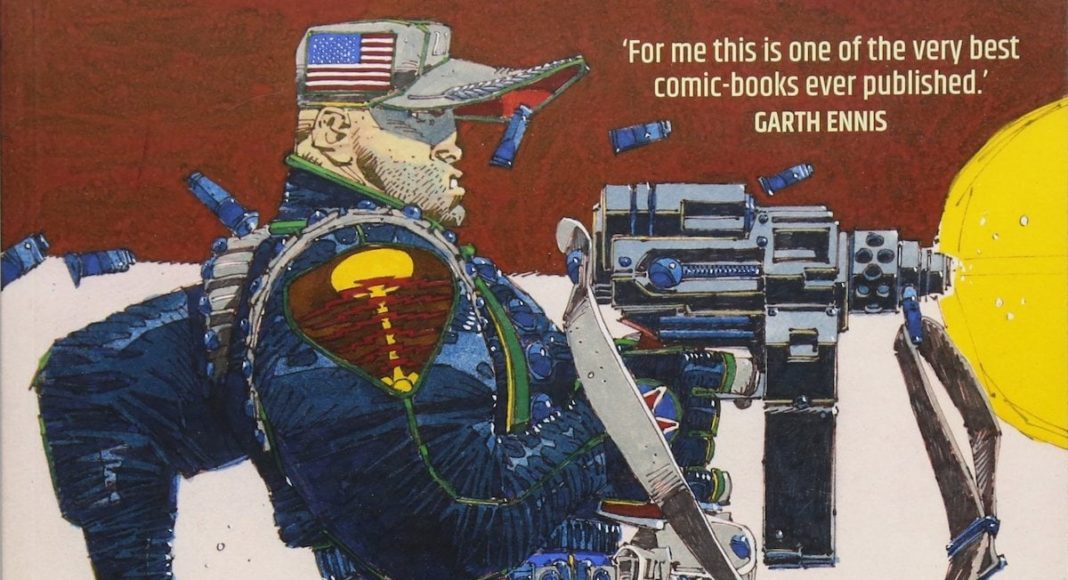Every week on “Sunday Page” an author has to choose a single page from a comic book. It could be for sentimental reasons o for a particular technical achievement. The conversation could lose itself in the open water of the comic book world but it will always start with the question: «If you had to choose a page from a comic book you love, what would you choose and why?».
This Sunday I’m out with Robert Sammelin, concept artist, illustrator and comic book artist. Born in Sweden, he works with brands like Entertainment Weekly, GQ, Wired, Esquire, Variety, Mondo. Nike, Boom! Studios, Image Comics and Dark Horse.

I fell in love with Mike McMahon’s work through Judge Dredd at an early age. Mike quite often experimented and changed his drawing style between projects and I remember how seeing this, I think it was about 1991 so I was 13 maybe, completely changed how I viewed comics.
The odd but brilliant compositions that only Mike can do (just consider how small the narrative subject, the tank, is in that first panel!), the strange irregular angularity and the heavy blacks, drawn with and meticulously filled in with permanent markers.
I still can’t fathom how he makes such great compositional use of small panels while still telling the story perfectly.
Like with a lot of the British comics of the era (Zenith, Watchmen, Button Man), the art accompanied and enhanced the story perfectly – the dirty colors and limited palette goes hand in hand with the bleakness and sadness of the story.
Also, how did you discovered this one in particular?
Growing up, comics to me were mostly Marvel/DC stuff, The Phantom or Modestly Blaise – the kind of well drawn, harmless fare your parents would pick up for you at the store.
In Sweden at the time however were these magazines (much like Cimoc or Creepy), always at the rack above the normal comics, monthly collections of various comics aimed at adults. After some time, I gathered the courage to stretch myself higher in the magazine rack and buy them – opening my eyes to ‘Euro’ comics, like Judge Dredd, Taxi, Dieter Lumpen, Corto Maltese, Ranxerox, Rocketeer, Manara and Crepax (comics I still consider my all time favourites). The page is from one of those late 80’s/early 90’s adult monthly comic collections, called Epix. What struck me after the initial chock and/or excitement from the overt sexual and violent nature, was that many of these comics weren’t drawn anything like the Marvel/DC kinds; there was variation and identity to these comics – they each had a soul of their own! I left the superheroes behind and never looked back.
Mick McMahon’s Judge Dredd comics bewildered me – most of my friends hated him and preferred Brian Bolland or Ron Smith – but I absolutely loved his work. It was punky and not at all realistic, nor was it supposed to be, and this just resonated with me – I loved drawing, but was never good at copying reality or drawing things like they usually looked. I always got the most enjoyment drawing for pure fun, not applying science or to portray with great technique or realism – seeing Mick’s work I felt he did exactly that. He didn’t seem to care too much about drawing well, he drew with feeling and confidence and it inspired me immensely.
The Last American hit me like a slap in the face – he had always been great at poses, panel composition and odd designs that were completely his own, but what he did here was something different altogether. Every panel is almost flat in perspective, he doesn’t seem to care to separate between fore and background, applying heavy blacks to both – but still it reads so well! For reading it does the zig-zag focus like any good page does, but the way he zooms in and out, pushing speech balloons around so you always read the image before the text, much like Micheluzzi – another favourite of mine.
You mentioned all this great euro comics, do you feel as an artist to be a swedish artist or your influences drove you away from your roots?
Sweden hasn’t really got a comics artist culture, and never did — it kind of died in the 90’s, when comic books disappeared from the racks (leaving only Disney, The Phantom and silly comedy strips), only to get some kind of foothold lately. Swedish comics these days tend to be satire or autobiographical stuff though…
I don’t particularly see much American influences in my work and I often get to hear how “European” it looks (always Americans saying it) — without much Swedish comparisons to be made, I’d say it’s definitely european.


